At first glance from the railway station, Uzhhorod resembles a southern coastal town. The local plants, scents and colours have a slight southern flavour to them. Uzhhorod’s latitude is virtually identical to that of Northern Crimea. By the time the first of Kyiv’s trees begin to blossom, Uzhhorod is already full of green lawns, blossoming jasmine and local sakura revealing its first petals. However, the city is also no stranger to the occasional April snowfall.
STREET CONTRASTS
Uzhhorod is very compact. It takes just a day or two to see all of its interesting sites. The small city center urges tourists to walk rather than drive, offering great opportunities to get some exercise in the fresh Carpathian air.
The first site is located right at the railway station. At this unexpected location, arriving visitors are greeted by a memorial to Heorhiy Kirpa, the late transportation minister, including his bust and info about the railway guru’s life and work—although bored passengers waiting for their trains aren’t likely to crowd around to see it. The railway square is also named after Kirpa, who built the city’s glamorous new railway station.
The next modern attraction is not far. A huge newly built Orthodox church in pseudo-Pskovsk style peeks out above the Carpathian foothills and delicate little houses. Some locals call it Samarkand due to the distinctive shape of its domes. The Moscow Patriarchate, though, seems to have little concern for aesthetics. Its only purpose is to make its voice heard among the nationalists of Zakarpattia, often derogatively named banderivtsi, after Stepan Bandera, one of the leaders of the nationalist movement in Western Ukraine.
Just a few minutes walk from the railway station, Uzhhorod’s downtown is free from aesthetic dissonance. The historical heart of the city is very elegant and fairly well preserved (photo 1). Unlike many other Ukrainian cities, it doesn’t look as if some wild strangers settled in and reduced everything to a post-war state. However, the city still boasts plenty of uneven pavement and piles of litter to satisfy tourists looking for a grittier experience.

Elegant Secessionist buildings line countless charming streets, the most beautiful of which is the pedestrian-only Corso St. Its name comes from the Roman Via del Corso, once a place for horse racing and other entertainment. Built in the 17-18th centuries, St. George’s Cathedral looks laconic and fits well into its surroundings. The more pompous and monumental Holy Cross Greek Catholic Cathedral (photo 6) and Bishop’s Residence are located next to St. George’s Cathedral. Independent of the Ukrainian Greek Catholic Church, the Greek Catholic Church of Zakarpattia was established after the 1646 Union of Uzhhorod.
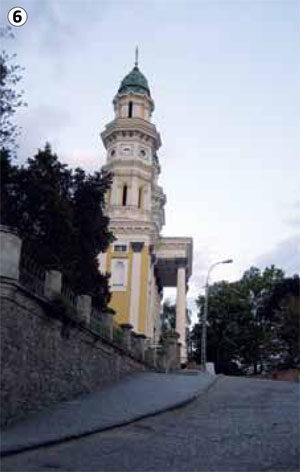
The local castle appears less impressive than those in Lutsk or Ostroh, yet it is charming and well preserved. Within the castle, one can find a museum of local history and the ancient foundation of the castle’s church. The observation platform offers a view of the entire city. Next to the castle wall is the Museum of Folk Architecture (photo 3) featuring bell towers and houses with wood-shingled roofs.
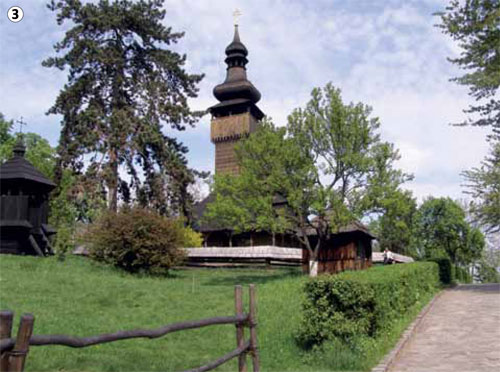
The pretty premises of the Zhupanat, formerly a local administration building, host a church and wine cellars next to an art museum with paintings by Yosyp Bokshai, Adalbert Erdeli, Andriy Kotska and other members of the Zakarpattia School. They painted in unique vibrant colours and combined Carpathian folk elements with a soft mid-twentieth century modernism.
Lovers of earlier artistic eras will learn from local guides that the Giotto-like Renaissance frescos on some walls of the St. Anna Church (photo 5) in Horiany, a village that is now part of Uzhhorod, trace back to the 16th century. According to some sources, the rotunda-like church was built in the 11th century. This minimalistic and beautiful church crowning a picturesque hill is not to be missed. It is one of the few destinations in Uzhhorod that is not located within walking distance.
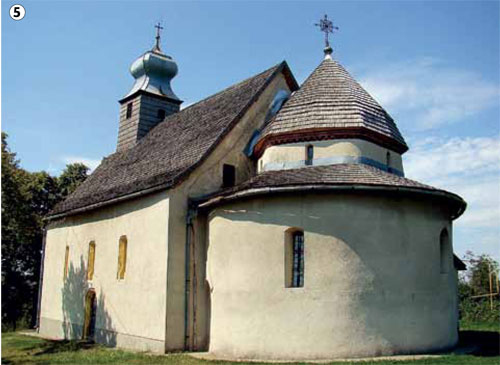
MULTIETHNIC TRANSCARPATHIA
Uzhhorod is among the most multiethnic cities in Ukraine. Its streets buzz with Ukrainian, Russian, Hungarian, Romani, Slovakian and Romanian. The impression is that Hungarian and Ukrainian have grown more popular in public venues over the past decade, although the locals speak their own dialect of Ukrainian rather than the common language. Some refer to it as a separate Ruthenian language while others think of it only as a dialect. In any case, numerous borrowed words make it strikingly different from the literary Ukrainian language. Even the local Greek Catholic church masses sound exotic.
Traces of Hungarian culture in Uzhhorod are the most visible of all, as Hungarians ruled the city for most of its history. They left many names, monuments and buildings as reminders, and the local cuisine has much in common with Hungarian cooking.
The Russian element is exotic and surprising for many in Uzhhorod. The Uzh river bank (photo 2) hosts a small chapel built by Russian émigrés who ended up in Uzhhorod after fleeing revolutionary turmoil in Russia. In soviet times, military and border guard servicemen joined them.
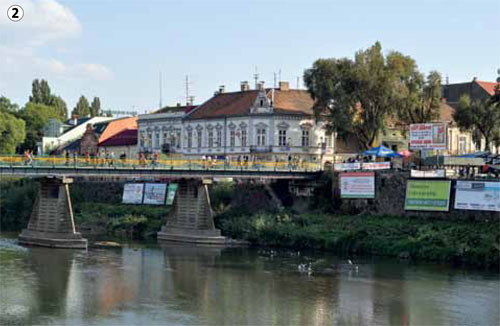
Uzhhorod, the city on the Uzh River, is unimaginable without the Roma. They live a more settled and less criminalized life here than in other parts of Ukraine. Still, they are segregated from other ethnic groups who tend to dislike them. Slovakians can be seen driving cars with Slovakian license plates and listening to Slovakian radio stations. The border with Slovakia lies virtually within the city’s limits, with Sobranetska St. leading right to it.
The only traces of Jews and Czechs, by contrast, include a few nice synagogue buildings, including the Great Synagogue (now the Philharmonic Society) (photo 4) built beside the Uzh in the Czech constructivist style of the 1930s. The city’s name also bears a Czech trace.
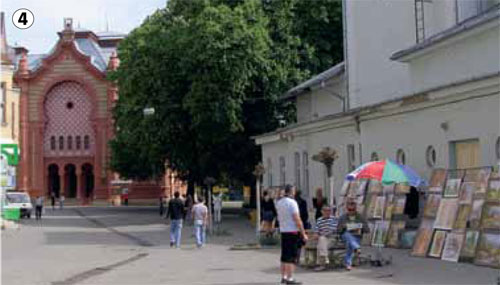
Prior to being annexed to Czechoslovakia, Uzhhorod was called Ungvar. The sakura trees were planted under the Czechs, too. And Czech signs, now rare, serve as another reminder of their former rule. One is at the Pid Zamkom (“By the Castle”) museum café decorated with other rarities including old cameras, hundreds of old bottles, placards, photographs, washstands, newspapers and cameras. And make sure you taste the misleadingly light young wine of Zakarpattia!
ARTISTIC LIFE
Every spring, Uzhhorod hosts Bereznevi Koty (March Cats), an erotic art festival, Zakarpatska Humoryna (Zakarpattia Comedy Festival) and Knyha-Fest, a book fair
UZHHOROD MENU
Bograch is a thick soup with meat, bell peppers, potatoes, carrots and spices
Banosh is a porridge consisting of corn-flour boiled in sour cream
Chovlent is meat with beans and hulled barley cooked in a pot.
Young wine is easy to overdrink. If you do, your Uzhhorod friends will tell the next guest about your adventures in town before he drinks his deceptive dose
Coffee – the locals are dead sure that the best coffee in Ukraine is served in Uzhhorod. Make sure you don’t compliment coffee from Lviv or elsewhere in front of them
Lunch at Pid Zamkom café, Detsa u notaria (a shot at the notary’s) or Ruta, a soviet-looking café at the bus station. They have inexpensive and delicious food and decent visitors
MUST SEE
Take a look at the local book store called Bovt Ivana Petrovtsia Fainy Knyhy (The Store of Ivan Petrovtsiy[1]: Good Books). It offers books focused on Ruthenia and Zakarpattia, including interesting rare publications from different countries in different languages. In 2005, I found the Ukrainian Futurism anthology there. Published in Nyíregyháza, Hungary, the book had long disappeared from other Ukrainian bookstores.
Detsa u notaria translated as “a shot at the notary’s” is another display of local flair decorated with funny pictures, inscriptions and items.
Note: Make sure you buy your ticket to Uzhhorod in advance. Virtually every place in Ukraine has direct transport connections to Uzhhorod, but the inflow of tourists can result in sold-out trains and buses.
DICTIONARY
Domú – home
Sio – hello
Aino – yes
Levesh – soup
Shvablyky – matches
Krumpli – potatoes
Paradychky – tomatoes
Tengerytsia – corn
Poi hevka – come here
Ondyka – there
[1] A Ruthenian writer

